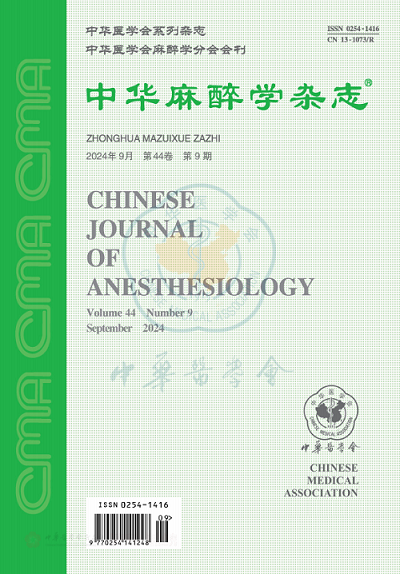Role of Nrf2-Gpx4 signaling pathway in Shenmai injection-induced reduction of myocardial ischemia-reperfusion injury: relationship with ferroptosis in rats
Q4 Medicine
引用次数: 0
Abstract
Objective To evaluate the role of nuclear factor erythroid 2-related factor 2 (Nrf2)-glutathione peroxidase 4 (GPX4) signaling pathway in Shenmai injection-induced reduction of myocardial ischemia-reperfusion (I/R) injury and the relationship with ferroptosis in rats. Methods Forty-eight SPF healthy adult male Sprague-Dawley rats, weighing 220-250 g, were divided into 4 groups (n=12 each) by a random number table method: sham operation group (S group), myocardial I/R group (IR group), Shenmai injection group (SM group), and Shenmai injection plus Nrf2 inhibitor group (SMM group). Acute myocardial I/R injury was induced by ligating the anterior descending brach of the left coronary artery for 30 min followed by 120-min reperfusion in anesthetized rats.In SM group, Shenmai injection 9 ml/kg was intravenously injected immediately before reperfusion.In group SMM, Nrf2 inhibitor ML385 30 mg/kg was intraperitoneally injected at 30 min before ischemia, and Shenmai injection 9 ml/kg was intravenously injected immediately before reperfusion.Six rats in each group were selected at 120 min of reperfusion, blood samples were collected from the left ventricle, the rats were then sacrificed, specimens were obtained from cardiac apex for examination of the ultrastructure and for determination of serum cardiac tropomin I( cTnI) level (by enzyme-linked immunosorbent assay), contents of Fe2+ and malondialdehyde (MDA) and superoxide dismutase (SOD) activity (by colometry), and expression of Nrf2, GPX4 and AcylCoA synthetase longchain family member 4 (ACSL4) (by Western blot). Another 6 rats in each group were selected to measure the myocardial infarct size. Results Compared with group S, the myocardial infarct size, serum cTnI concentrations, and myocardial Fe2+ and MDA contents were significantly increased, the activity of SOD was decreased, the expression of Nrf2 and GPX4 was down-regulated, and the expression of ACSL4 was up-regulated in IR, SM and SMM groups (P 0.05). Compared with group SM, the myocardial infarct size, serum cTnI concentrations, and myocardial Fe2+ contents were significantly increased, the activity of SOD was decreased, the expression of Nrf2 and GPX4 was down-regulated, and the expression of ACSL4 was up-regulated in group SMM (P<0.05). Conclusion Activation of Nrf2-Gpx4 signaling pathway is involved in Shenmai injection-induced reduction of myocardial I/R injury and is related to inhibiting ferroptosis in rats. Key words: NF-E2-related factor 2; Glutathione peroxidase; SAPONINS; Myocardial reperfusion injury; Cell deathNrf2-Gpx4信号通路在参麦注射液减轻大鼠心肌缺血再灌注损伤中的作用:与脱铁性贫血的关系
目的探讨核因子-红细胞2相关因子2 (Nrf2)-谷胱甘肽过氧化物酶4 (GPX4)信号通路在参麦注射液诱导大鼠心肌缺血再灌注(I/R)损伤减轻中的作用及其与铁凋亡的关系。方法48只SPF级健康成年雄性sd - dawley大鼠,体重220 ~ 250 g,采用随机数字表法分为4组,每组12只:假手术组(S组)、心肌I/R组(IR组)、参麦注射液组(SM组)、参麦注射液加Nrf2抑制剂组(SMM组)。麻醉大鼠左冠状动脉前降支结扎30min,再灌注120min,诱导急性心肌I/R损伤。SM组在再灌注前立即静脉注射参麦注射液9 ml/kg。SMM组缺血前30 min腹腔注射Nrf2抑制剂ML385 30 mg/kg,再灌注前立即静脉注射参麦注射液9 ml/kg。再灌注120 min时,每组取6只大鼠,左心室取血,处死,心尖取标本,观察超微结构,测定血清心肌tropomin I(cTnI)水平(酶联免疫吸附法),测定血清铁离子(Fe2+)、丙二醛(MDA)含量和超氧化物歧化酶(SOD)活性(比色法),测定Nrf2的表达。GPX4和酰基辅酶a合成酶长链家族成员4 (ACSL4) (Western blot)。每组取6只大鼠测量心肌梗死面积。结果与S组比较,IR、SM、SMM组大鼠心肌梗死面积、血清cTnI浓度、心肌Fe2+、MDA含量显著升高,SOD活性降低,Nrf2、GPX4表达下调,ACSL4表达上调(P < 0.05)。与SM组比较,SMM组大鼠心肌梗死面积、血清cTnI浓度、心肌Fe2+含量显著升高,SOD活性降低,Nrf2、GPX4表达下调,ACSL4表达上调(P<0.05)。结论Nrf2-Gpx4信号通路的激活参与参麦注射液诱导大鼠心肌I/R损伤的减轻,并与抑制铁下沉有关。关键词:nf - e2相关因子2;谷胱甘肽过氧化物酶;皂苷;心肌再灌注损伤;细胞死亡
本文章由计算机程序翻译,如有差异,请以英文原文为准。
求助全文
约1分钟内获得全文
求助全文

 求助内容:
求助内容: 应助结果提醒方式:
应助结果提醒方式:


